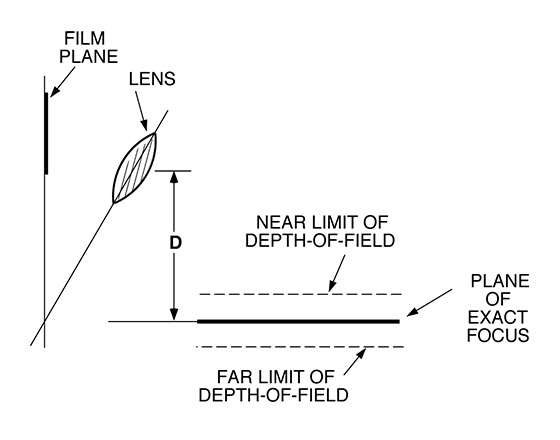
More Information About the Object Field Method
of estimating Depth of Field for View Cameras

Figure 23 from page 86 of The INs and OUTs of FOCUS.
(Note that for this configuration - Plane of Exact Focus perpendicular to Film Plane - D and J denote the same distance.)
In The INs and OUTs of FOCUS I included a brief addendum intended to provide an introduction to depth of field as applicable to view cameras. This brief introduction addressed both the image field and the object field method. Above is a re-presentation of Fig. 23 from that explanation. In FOCUSING the VIEW CAMERA I described the situation for the image field in considerable detail, but failed to amplify much further regarding the object field. For view cameras, the object field method is pretty simple, and so I thought there was not much needed beyond what is in the earlier addendum.
It has always bothered me, however, that my coverage of the object field method for view cameras lacked proof that it worked. In about 2005 I undertook an experiment to prove to myself that it did work, but never published those rsults. This page seeks to correct that situation.
The aspect of the object field method that perhaps defies intuition is that, for the object field method, depth of field does not vary with distance from the lens to the subject (R is the symbol used for this in the book). That is, the depth of field is constant for all lens-to-subject distances. This is clear from the illustration shown above. But does it really work?
I decided to reproduce the situation shown in the above figure as closely as possible: a view camera adjusted with the film in a vertical plane, but the plane of sharp focus situated in the horizontal plane. I used a 4x5 inch Toyo view camera with a 90mm lens adjusted as shown in the next two illustrations.
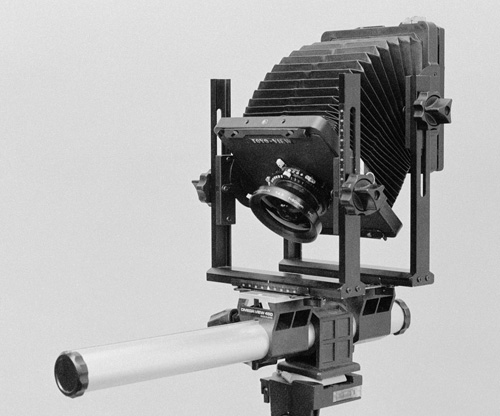
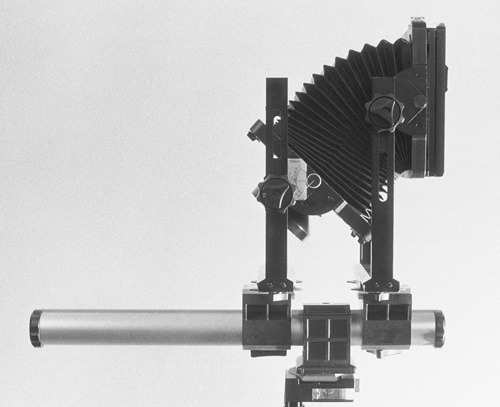
Two views of the view camera adjusted as used in the experiment.
The camera is essentially focused on the distance scale placed on the top of the view camera's main rail. The lens tilt angle is a rather extreme 45 degrees. No lens swing was used, amd no shift applied at either the lens or the film. The film holder is vertical and perpendicular to the camera's focusing rail.
Along side the camera, I placed a large piece of poster board with parallel black lines drawn horizontally. The center-most line is heavier than the others and placed at the same vertical hight as the scale on the top of the camera's focusing rail. Every 5th line is a little heavier and every tenth line a bit heavier again. The poster board with the lines is vertical, but angled about 15 degrees across the azimuth direction in which the camera is pointed.
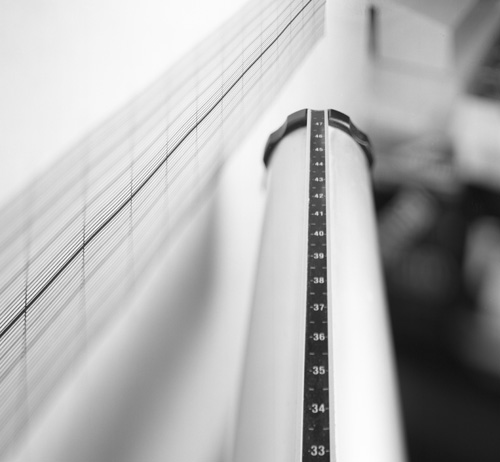
Immediately above is the resulting photograph. It is readily seen that the heavy central line drawn on the poster board is in focus throughout. The lines parallel to it are progressively out of focus as disance from the cener line increases. It is still, however, not clear from this photograph that the depth of field does not vary with distance from the camera lens.
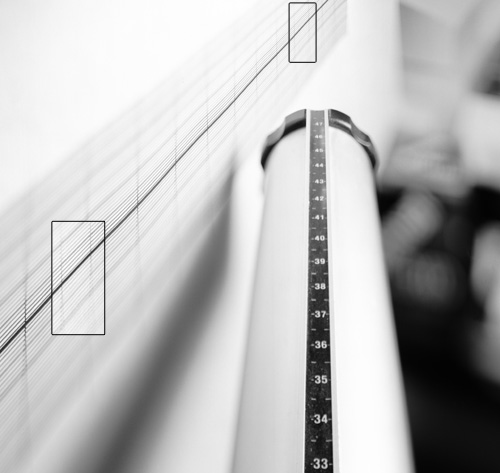
Here is a near-identical picture, but with some minor manipulation in Photoshop. What I did was to copy the portion of the image contained in the top rectangle and paste it on top of the image where the lines are closer to the camera. I then magnified the pasted image to make the line spaceing equal to that of the image underneath it. We see that it is almost impossible to detect that the pasted image does not belong where it is placed. This implies directly that the vertical object-method depth of field is the same at both locations: it does not vary with distance from the lens. This is in accord with the first illustration.
This experiment was done in about 2005 and I unfortunately no longer recall the line spaving or the aperature of the lens when this photograph was taken. I don't claim that the end results are perfect, but they are certainly close to expectations.
Harold M. Merklinger
23 September 2017.
Return to Main Page Table of Contents.